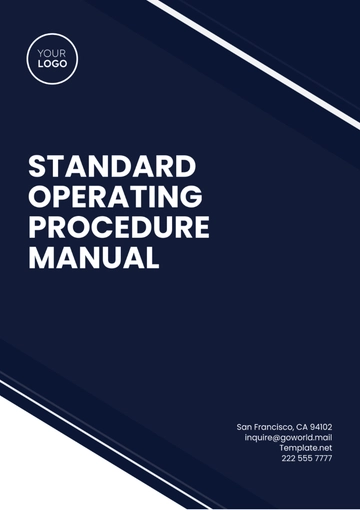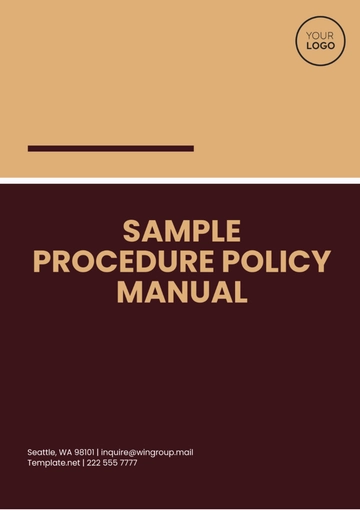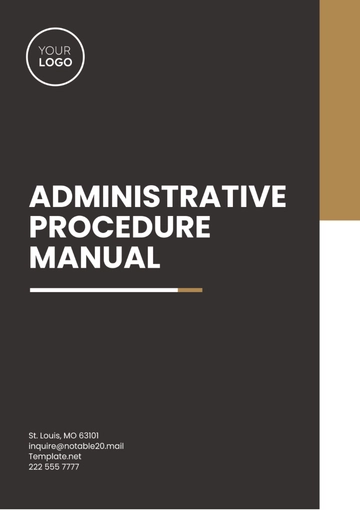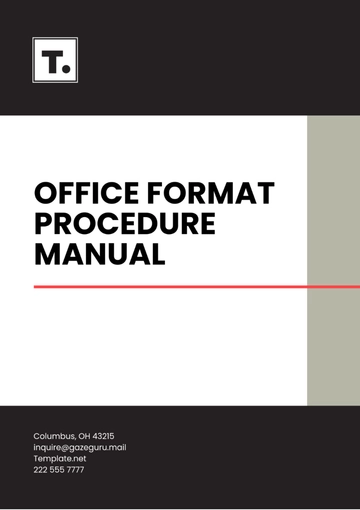Free Finance Mergers & Acquisitions Policy & Procedure Manual

I. Introduction
A. Purpose
The primary purpose of this manual is to provide a comprehensive and standardized framework for guiding the organization's M&A activities. In establishing this manual, our goal is to ensure a systematic approach to M&A transactions, aligning them with the strategic objectives of the organization. By defining clear processes and protocols, we aim to enhance transparency, mitigate risks, and facilitate informed decision-making throughout the M&A lifecycle. This manual serves as a strategic tool to optimize the financial outcomes of M&A endeavors, contributing to the overall growth and sustainability of the organization.
B. Target Audience
This manual is designed to cater to a diverse audience involved in various stages of the M&A process. The primary audience includes executives and decision-makers responsible for shaping the organization's M&A strategy. Finance professionals engaged in financial analysis, valuation, and deal structuring will find detailed guidelines to ensure financial prudence. Legal advisors will benefit from sections addressing compliance with regulatory frameworks, while operational teams will gain insights into the integration planning process. Additionally, this manual is a valuable resource for external consultants and auditors engaged in assessing the organization's M&A practices. By targeting this broad audience, the manual ensures a holistic and collaborative approach to M&A activities.
II. Authority and Responsibilities
A. Decision-Making Authority
Executive Leadership
Ultimate decision-making authority for approving M&A transactions rests with the executive leadership, including the CEO, CFO, and other designated executives.
Executive leadership is responsible for aligning M&A activities with the organization's overall strategic objectives and assessing their impact on shareholder value.
M&A Committee
Establish a dedicated M&A committee consisting of senior executives and relevant stakeholders.
The M&A committee is entrusted with reviewing and evaluating potential M&A opportunities, ensuring a thorough assessment of strategic, financial, and operational aspects.
B. Roles and Responsibilities
Deal Champions
Appoint designated individuals as Deal Champions responsible for championing specific M&A transactions from initiation to completion.
Deal Champions coordinate cross-functional teams, ensuring collaboration among finance, legal, operations, and other departments.
Finance Professionals
Finance teams play a crucial role in financial analysis, due diligence, and valuation.
Responsibilities include preparing financial models, conducting scenario analyses, and assessing the financial viability of potential targets.
Legal Advisors
Legal advisors provide expertise in navigating legal complexities associated with M&A transactions.
Responsibilities include assessing regulatory compliance, drafting and reviewing contracts, and advising on legal implications throughout the process.
Operational Teams
Operational teams are involved in the integration planning process.
Responsibilities include identifying synergies, addressing cultural differences, and ensuring a smooth transition post-acquisition.
Human Resources
Human Resources (HR) plays a critical role in managing workforce transitions during M&A activities.
Responsibilities include assessing talent needs, addressing employee concerns, and facilitating the integration of human capital.
Risk Management Team
Establish a dedicated risk management team responsible for identifying, assessing, and mitigating risks associated with M&A transactions.
Responsibilities include conducting risk assessments, developing risk mitigation strategies, and ensuring compliance with risk management policies.
IT and Technology Teams
IT and technology teams are crucial for assessing the technological compatibility and integration of systems between the acquiring and target companies.
Responsibilities include evaluating IT infrastructure, addressing cybersecurity concerns, and ensuring a seamless transition of technology platforms.
III. Deal Criteria and Evaluation
A. Criteria
The table below outlines the criteria for evaluating potential M&A opportunities:
Criteria | Description |
Strategic Fit | Evaluate how well the target aligns with the organization's overall strategic goals and mission. |
The criterion of strategic fit is paramount in M&A activities as it ensures that any potential acquisition aligns seamlessly with the overarching strategic goals and mission of the organization. When evaluating strategic fit, the organization aims to ascertain how well the target complements existing operations and contributes to the long-term vision. This involves considering factors such as shared values, market positioning, and the potential for synergies. A strong strategic fit mitigates the risk of divergent objectives and promotes a coherent organizational strategy. A successful acquisition should not only enhance the current business landscape but also propel the organization toward its strategic objectives, creating value for shareholders and stakeholders alike.
B. Valuation Methods
The table below outlines the methods and approaches used for valuing potential M&A targets:
Valuation Method | Description |
Comparable Company Analysis (CCA) | Evaluate the target's value based on the valuation multiples of similar publicly traded companies. |
Comparable Company Analysis (CCA) is a crucial valuation method that involves comparing the target's financial metrics with those of similar publicly traded companies. This method provides a benchmark for assessing the target's relative value within the industry, considering market trends and performance. By examining comparable companies, organizations gain insights into industry norms, competitive positioning, and valuation multiples. CCA is particularly valuable in determining whether the proposed acquisition is financially justified compared to industry standards. This method aids in identifying outliers and understanding the potential impact of market dynamics on the target's valuation. In essence, CCA is a strategic tool that enables organizations to make informed decisions based on a comprehensive understanding of the target's position within its industry landscape.
IV. Due Diligence Process
A. Financial Due Diligence
Financial Statements Analysis
Examine the target's financial statements, including income statements, balance sheets, and cash flow statements.
Analyze trends, identify anomalies, and assess the overall financial stability and performance of the target.
Working Capital Assessment
Evaluate the target's working capital, focusing on its current assets and liabilities.
Assess the adequacy of working capital for sustaining day-to-day operations and its potential impact on the acquisition.
Debt and Liabilities Review
Scrutinize the target's existing debt obligations and liabilities.
Evaluate the terms, conditions, and potential risks associated with the target's debt structure.
Tax Due Diligence
Conduct a thorough review of the target's tax position.
Identify potential tax liabilities, obligations, and any associated risks that may impact the overall transaction.
Financial Projections Analysis
Evaluate the accuracy and reliability of the target's financial projections.
Assess the assumptions underlying the projections and their alignment with the organization's strategic goals.
B. Legal Due Diligence
Corporate Structure and Governance
Review the target's corporate structure, including subsidiaries, joint ventures, and affiliations.
Assess the effectiveness of corporate governance practices and compliance with legal requirements.
Contracts and Agreements
Examine existing contracts, agreements, and legal obligations of the target.
Identify any contractual limitations, potential breaches, or legal challenges that may impact the transaction.
Intellectual Property (IP) Assessment
Conduct a thorough assessment of the target's intellectual property portfolio.
Identify existing patents, trademarks, copyrights, and any potential infringement issues.
Litigation Review
Investigate ongoing or pending litigation involving the target.
Assess potential legal liabilities and their impact on the organization's risk profile.
V. Financing Structure
In the intricate landscape of M&A, determining the appropriate financing structure is a pivotal aspect that influences the success and sustainability of the transaction. The table below outlines the financing structure considerations:
Financing Method | Description |
Cash | Utilize cash reserves for financing the acquisition. |
Utilizing cash reserves for financing an acquisition provides an immediate and straightforward approach, facilitating a swift and seamless transaction. This method allows the organization to leverage its existing liquidity, potentially gaining negotiation advantages and demonstrating financial strength to stakeholders. However, the decision to use cash should be carefully weighed, considering the impact on overall liquidity and the organization's ability to fund other strategic initiatives or unforeseen expenses. While it minimizes the need for external financing and interest payments, depleting significant cash reserves may limit flexibility for future investments or operational requirements.
VI. Legal and Regulatory Compliance
A. Antitrust and Regulatory Review
Antitrust Assessment
Conduct a thorough analysis to identify potential antitrust issues associated with the proposed acquisition.
Evaluate the impact on market competition, potential market dominance, and compliance with antitrust laws.
Regulatory Compliance
Ensure compliance with industry-specific regulations and legal requirements.
Develop a comprehensive understanding of regulatory frameworks governing the industries involved in the M&A transaction.
B. Disclosure Obligations
Stakeholder Communication
Develop a communication plan outlining the dissemination of information to internal and external stakeholders.
Clearly define the frequency, format, and content of communications to maintain transparency throughout the M&A process.
Confidentiality Protocol
Maintain confidentiality agreements, and mitigate the risk of unauthorized disclosures.
VII. Integration Planning
A. Cultural Integration
Cultural Assessment
Conduct a comprehensive assessment of the cultural nuances of both entities.
Identify similarities, differences, and potential challenges in merging organizational cultures.
Change Management Strategies
Implement initiatives to address employee concerns and encourage collaboration.
B. Operational Integration
Identify synergies in operations, resources, and processes between entities.
Develop a roadmap for realizing operational efficiencies and maximizing benefits.
Technology Integration
Assess the compatibility of technology systems and infrastructure.
VIII. Continuous Improvement
A. Approaches
Conduct regular reviews of past M&A transactions to extract lessons learned.
Implement continuous improvement strategies based on insights gained from historical experiences.
B. Adapting Strategies
Maintain flexibility in adapting strategies based on real-time feedback and evolving market conditions.
Implement changes as needed to optimize the organization's approach to M&A activities.
- 100% Customizable, free editor
- Access 1 Million+ Templates, photo’s & graphics
- Download or share as a template
- Click and replace photos, graphics, text, backgrounds
- Resize, crop, AI write & more
- Access advanced editor
Establish clarity with the editable Finance Mergers & Acquisitions Policy & Procedure Manual Template, only on Template.net! This customizable solution sets the standard for compliance and efficiency. Tailor easily using our AI Editor Tool, ensuring a robust manual guiding your team through mergers and acquisitions. Enhance your policy framework with flexibility today!





























